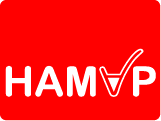About HAMAP
What is HAMAP?
HAMAP (High-quality Automated and Manual Annotation of Proteins) is a rule-based automatic annotation system for the functional annotation of protein sequences.
It consists of a collection of family profiles for determining protein family membership, and their associated annotation rules for attachment of functional annotation to member sequences.
Both HAMAP family profiles and annotation rules are created and maintained by experienced curators using experimental data from expertly annotated UniProtKB/Swiss-Prot entries.
[More...]
HAMAP can be used for the functional annotation of protein sequences using our HAMAP-Scan interface. In addition, HAMAP is a member database of InterPro, and is also used to annotate protein records in UniProtKB via UniProt's automatic annotation pipeline as part of UniRule.
HAMAP can be used for the functional annotation of protein sequences using our HAMAP-Scan interface. In addition, HAMAP is a member database of InterPro, and is also used to annotate protein records in UniProtKB via UniProt's automatic annotation pipeline as part of UniRule.
Update frequency
The HAMAP release is concurrent with every release of UniProtKB. New families are added in each release, and existing families are periodically updated.
Copyright
HAMAP is copyrighted by the SIB Swiss Institute of Bioinformatics
and distributed under the Creative Commons Attribution (CC BY 4.0) License.
How to cite
If you use HAMAP or HAMAP-Scan, please cite:
"HAMAP in 2015: updates to the protein family classification and annotation system." Nucleic Acids Res. 43:D1064-D1070(2015).
The list of all our publications can be found in the documentation section.
The list of all our publications can be found in the documentation section.
The HAMAP team
HAMAP is brought to you by members of the Swiss-Prot Group
at the SIB Swiss Institute of Bioinformatics in Geneva, Switzerland.
Biocuration
|
Software development
|
Coordination
|
Funding
HAMAP activities at the SIB are supported by the Swiss Federal Government through the State Secretariat for Education, Research and Innovation SERI, and the Swiss National Science Foundation (SNSF).
